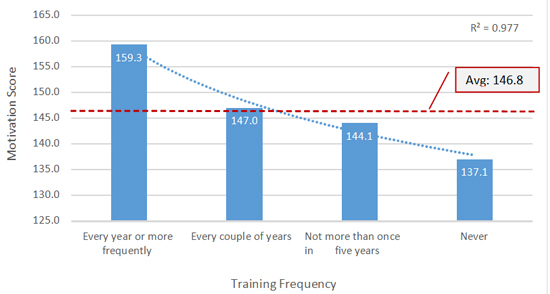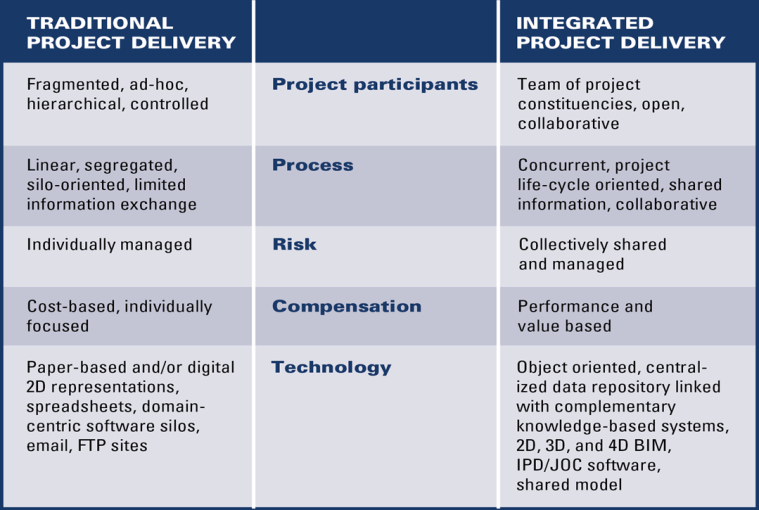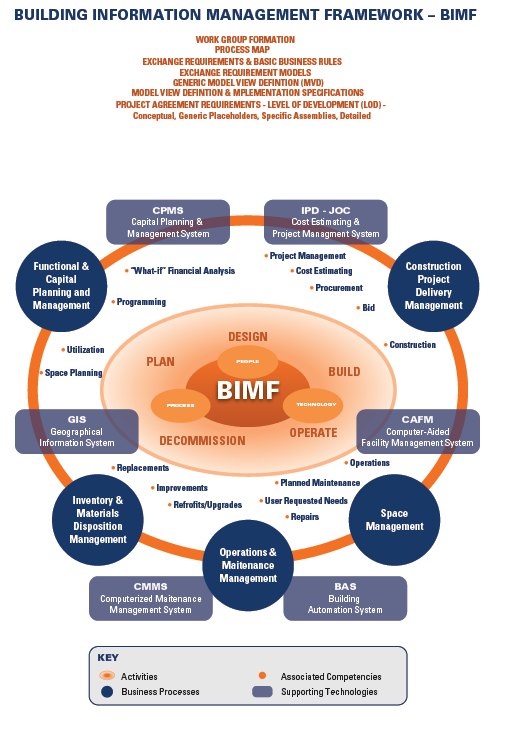By Peter Cholakis
Published in the March 2013 issue of Today’s Facility Manager
Emergent disruptive technologies and construction delivery methods are altering both the culture and day-to-day practices of the construction, renovation, repair, and sustainability of the built environment. Meanwhile, a shifting economic and environmental landscape dictates significantly improved efficiencies relative to these facility related activities. This is especially important to any organization dependent upon its facilities and infrastructure to support and maintain its core mission.
The disruptive digital technologies of building information modeling (BIM) and cloud computing, combined with emergent collaborative construction delivery methods are poised to alter the status quo, ushering in increased levels of collaboration and transparency. A disruptive technology is one that alters the very fabric of a business process or way of life, displacing whatever previously stood in its place. BIM and cloud computing fit the profile of disruptive technologies, individually, and when combined these stand to create a tidal wave of change.
BIM is the life cycle management of the built environment, supported by digital technology. While a great deal of emphasis has been placed upon 3D visualization, this is just a component of BIM. The shift from a “first cost mentality” to a life cycle cost or total cost of ownership is a huge change for many. Improving decision making practices and applying standardized terms, metrics, and cost data can also prove challenging. An understanding and integration of the associated knowledge domains important to life cycle management is required, resulting in what is now being referred to as “big data.”
Cloud computing is also a disruptive technology, and it’s one that impacts several areas. The National Institute of Standards and Technology (NIST) definition of cloud computing is as follows, “Cloud computing is a model for enabling ubiquitous, convenient, on demand network access to a shared pool of configurable computing resources (e.g., networks, servers, storage, applications, services) that can be rapidly provisioned and released with minimal management effort or service provider interaction. The cloud model is composed of five essential characteristics, three service models, and four deployment models.”
It is perhaps helpful to define cloud computing in terms of its benefits. Cloud computing enables far greater levels of collaboration, transparency, and information access previously unavailable by traditional client/server, database, or even prior generation web applications. Multiple users can work on the same data set with anyone, anywhere, anytime, in multicurrency, multilanguage environments. All changes can be tracked to “who did what” within seconds (potentially the best form of security available), and information is never deleted.
The disruptive technologies of BIM and cloud computing will accelerate the adoption of emergent construction delivery methods and foster new frameworks. Design-bid-build, the traditional construction delivery method for decades, is inherently flawed. As a lowest bid deployment it immediately sets up adversarial relationships for involved parties. Owners prepare a solicitation for construction projects based on their understanding of them1, with or without third-party A/E assistance, and in most cases they go out in search of the lowest bidder. Then without a thorough understanding of the owner’s facility, bidders base their responses on the owner’s solicitation, plans, and specifications. Owners typically allow a period of time for bidders’ questions and clarifications; but the quality of this interchange is at best questionable if based solely on a written scope, plans and specifications, and/or a meeting with suppliers.
Design-build, arguably a step in right direction, falls short of bringing all stakeholders together. More responsibility of design and construction is shifted to the contractor and/or A/E. However, the dual level participation structure doesn’t assure the interests of all parties are equally addressed. Furthermore, the design-build process is typically reserved for major new construction projects versus the numerous sustainability, repair, renovation projects, and minor new construction projects typically encountered by facility managers (fms).
Because BIM brings together previously disparate information into a framework that enables decision support, using the technology requires a collaborative construction delivery method. The integration of the domain knowledge and robust processes required to allow fms, A/Es, and other stakeholders to achieve heightened levels of information sharing and collaboration is enabled by methods that include Integrated Project Delivery (IPD) and Job Order Contracting (JOC).
Key characteristics of these emergent construction delivery methods include: choices based on best value; some form of pricing transparency; early and ongoing information sharing among project stakeholders; appropriate distribution of risk; and some form of financial incentive to drive performance.
Both IPD and JOC allow, if not require, owner cost estimators and project managers to “partner” with contractors, subcontractors, and A/Es to conceptualize, create, cost, prioritize, start, and report upon projects—in the very early phases of construction.
IPD, JOC, and Simplified Acquisition of Base Civil Engineering Requirements (SABER)—the U.S. Air Force term for applying JOC practices—are practiced simultaneously by a growing number of organizations and supported by digital technologies. These construction delivery processes are embedded within software to allow for rapid, cost-effective, and consistent deployment as well as the associated level of collaboration and transparency.
BIM and cloud computing are disruptive technologies that will accelerate the adoption of emergent construction delivery methods such as IPD and JOC. Construction delivery methods set the tone and level of interaction among project participants and can be viewed as the management process framework. When supported by BIM and cloud computing, the life cycle management of the built environment, and the associated management of big data, can be expected to become commonplace for many construction projects.

Cholakis
Cholakis is chief marketing officer for 4Clicks Solutions, LLC, a Colorado Springs, CO provider of cost estimating and project management software. With expertise in facilities life cycle costs and total cost of ownership in various market segments, he is involved in numerous industry associations and committees including the American Society of Safety Engineers, Association for the Advancement of Cost Engineering, Society of American Military Engineers, BIM Library Committee-National Institute for Building Sciences (NIBS), and National Building Information Model Standard Project Committee.
1 “The Art of Thinking Outside the Box;” Vince Duobinis; 2008.










